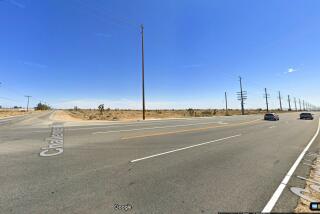Lane-splitting: Is it really OK to do that?
- Share via
You’re stuck on the 405 freeway. All lanes have come to a dead stop, when suddenly a motorcycle roars past at high speed, inches away, scaring the wits out of you.
It’s called lane-splitting, a harrowing maneuver by motorcyclists to break through freeway traffic jams and bypass slow-moving vehicles. Although motorcyclists love it, motorists often find it annoying and dangerous.
For the record:
12:00 a.m. May 22, 2004 For The Record
Los Angeles Times Saturday May 22, 2004 Home Edition Main News Part A Page 2 National Desk 1 inches; 57 words Type of Material: Correction
Lane-splitting -- In a column about motorcycle lane-splitting in Wednesday’s Highway 1 section, Candysse Miller was identified as being with the Insurance Institute for Highway Safety. She is executive director of the Insurance Information Network of California. Also, Ron Burch was identified as a sergeant with the California Highway Patrol. His title is CHP officer and spokesman.
For The Record
Los Angeles Times Wednesday May 26, 2004 Home Edition Highway 1 Part G Page 2 Features Desk 2 inches; 65 words Type of Material: Correction
Motorcycles -- In a column on motorcycle lane-splitting in the May 19 edition of Highway 1, Candysse Miller, executive director of the Insurance Information Network of California, was incorrectly identified as being from the Insurance Institute for Highway Safety. In the same column, California Highway Patrol spokesman Ron Burch was mistakenly identified as a sergeant with the department. His title is CHP officer and spokesman.
California is the only state that allows motorcyclists to drive between vehicle lanes if it is done in a safe manner.
And as the number of motorcycle riders has increased, fatalities are up and lane-splitting also appears to be on the increase, says Sgt. Ron Burch of the California Highway Patrol.
In 2003, there were 3,592 motorcycle fatalities nationwide, according to recent figures released by the National Highway Traffic Safety Administration. The death toll represents an 11% surge over the previous year in the number of cyclists killed.
California led the nation in 2002 with 323 motorcycle fatalities. Though neither the CHP nor the NHTSA keeps statistics on the number of accidents involving motorcycles splitting lanes, anecdotal information indicates the practice has led to serious injuries and deaths.
Of the five fatal motorcycle accidents Burch worked during his five years as a CHP motorcycle officer, two of them involved riders who were splitting lanes on the freeways. The other three involved excessive speed.
“Motorcycling in general is inherently dangerous. It’s startling that lane-splitting is even allowed,” says Judy Stone, president of Advocates for Highway Safety, a national nonprofit organization based in Washington, D.C. “Drivers can’t always see them coming, it surprises people.”
Stone, whose group advocates strong laws requiring all riders to wear helmets, says head injuries are the leading cause of death in motorcycle crashes.
Stone argues that the rise in motorcycle deaths nationwide could be, in part, attributed to the fact that some states repealed helmet laws and others relaxed requirements on the protective gear. California, 18 other states and the District of Columbia require helmet use for all motorcycle drivers and passengers. In 28 other states, only those under a certain age, generally 18, are required to wear helmets. Three states -- Colorado, Illinois and Iowa -- have no helmet requirements, according to the group.
Though motorcyclists often clash with safety advocates over issues such as helmet use, the lane-splitting issue has at least one rider organization concerned.
“We don’t advocate high-speed lane-splitting. It’s dangerous and stupid, not to mention illegal just about everywhere in the country,” says Jeff Hennie of the influential Motorcycle Rider Foundation, also based in Washington.
As vice president of the group’s government affairs, Hennie says lane-splitting is certainly a way to reduce traffic congestion in California, but riders should drive responsibly, particularly “in this age of road rage.”
“Many motorcycle drivers are very responsible and I try to make room for them,” says Candysse Miller, of the Insurance Institute for Highway Safety. But motorcyclists who “speed and drive recklessly, racing between lanes ... and driving in and out of carpool lanes are scary. I guess it’s a ‘live free or die’ attitude.”
Art Friedman, an avid California motorcycle rider and senior editor of Motorcycle Cruising and Motorcyclist magazine, says more research needs to be done in motorcycle safety, including a closer look at the advantages and risks of lane-splitting.
Though it can alleviate traffic congestion, Friedman says, advocates of lane-splitting have to consider that “we have more people splitting lanes these days and cars are bigger and wider.”
Speeding between vehicles that are stopped or moving slowly “is not very smart. It just lessens your reaction time and most officers will write you a ticket for doing that,” he says.
If a motorcyclist is lane-splitting and either veers into one of the lanes or loses control and collides with another vehicle in a lane, the motorcyclist is at fault, says Burch of the Highway Patrol.
To safely split lanes in slow or stopped traffic, Burch says, speeds should not be more than 10 mph faster than the flow of traffic. Even though lane-splitting is legal in the state, officers have the discretion to issue citations for unsafe speed or reckless behavior.
“If traffic is stopped and a motorcycle is splitting lanes at 60 mph, anything can happen. Someone could open a car door or make a lane change. There is no way you will be able to take an evasive maneuver to prevent a collision,” Burch warns.
Jeanne Wright can be reached at jeanrite@aol.com





